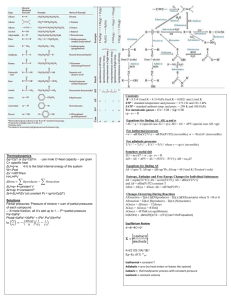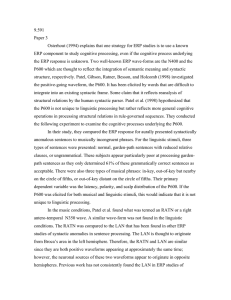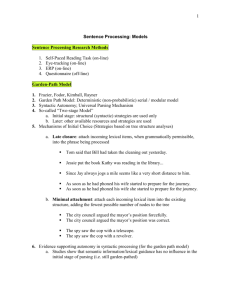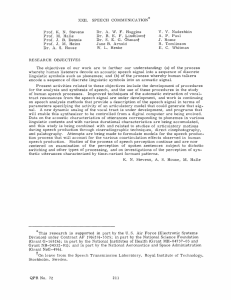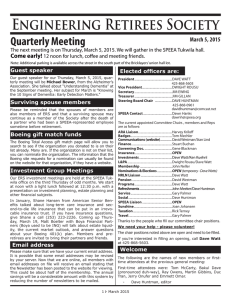Sentence Processing 9.591J Short Paper # 3
advertisement
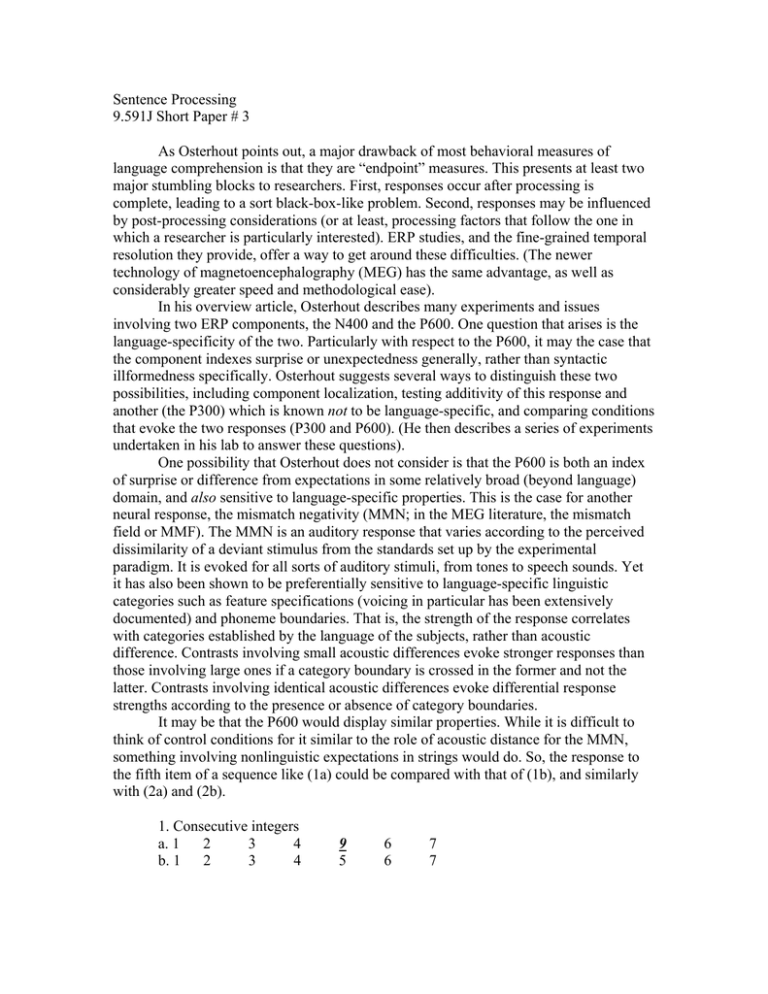
Sentence Processing 9.591J Short Paper # 3 As Osterhout points out, a major drawback of most behavioral measures of language comprehension is that they are “endpoint” measures. This presents at least two major stumbling blocks to researchers. First, responses occur after processing is complete, leading to a sort black-box-like problem. Second, responses may be influenced by post-processing considerations (or at least, processing factors that follow the one in which a researcher is particularly interested). ERP studies, and the fine-grained temporal resolution they provide, offer a way to get around these difficulties. (The newer technology of magnetoencephalography (MEG) has the same advantage, as well as considerably greater speed and methodological ease). In his overview article, Osterhout describes many experiments and issues involving two ERP components, the N400 and the P600. One question that arises is the language-specificity of the two. Particularly with respect to the P600, it may the case that the component indexes surprise or unexpectedness generally, rather than syntactic illformedness specifically. Osterhout suggests several ways to distinguish these two possibilities, including component localization, testing additivity of this response and another (the P300) which is known not to be language-specific, and comparing conditions that evoke the two responses (P300 and P600). (He then describes a series of experiments undertaken in his lab to answer these questions). One possibility that Osterhout does not consider is that the P600 is both an index of surprise or difference from expectations in some relatively broad (beyond language) domain, and also sensitive to language-specific properties. This is the case for another neural response, the mismatch negativity (MMN; in the MEG literature, the mismatch field or MMF). The MMN is an auditory response that varies according to the perceived dissimilarity of a deviant stimulus from the standards set up by the experimental paradigm. It is evoked for all sorts of auditory stimuli, from tones to speech sounds. Yet it has also been shown to be preferentially sensitive to language-specific linguistic categories such as feature specifications (voicing in particular has been extensively documented) and phoneme boundaries. That is, the strength of the response correlates with categories established by the language of the subjects, rather than acoustic difference. Contrasts involving small acoustic differences evoke stronger responses than those involving large ones if a category boundary is crossed in the former and not the latter. Contrasts involving identical acoustic differences evoke differential response strengths according to the presence or absence of category boundaries. It may be that the P600 would display similar properties. While it is difficult to think of control conditions for it similar to the role of acoustic distance for the MMN, something involving nonlinguistic expectations in strings would do. So, the response to the fifth item of a sequence like (1a) could be compared with that of (1b), and similarly with (2a) and (2b). 1. Consecutive integers a. 1 2 3 4 b. 1 2 3 4 9 5 6 6 7 7 2. Consecutive even integers a. 2 4 6 8 17 b. 2 4 6 8 10 12 12 14 14 The deviant is in the fifth rather than final position to avoid the potential confound of wrapping-up factors such as Osterhout discusses. I’m not sure whether it would be better to continue the sequence from the item preceding the stimulus or the stimulus itself, or if skipping the item the deviant replaces is best (i.e., for (1a), 4-9-6-7, or 4-9-5-6, or 4-9-1011?). Also, using numbers may present other problems. Arithmetic patterns might be expected to behave like linguistic ones if they are part of the same module dealing with recursive hierarchical structure, as some psychologists believe. Even if mathematics constitutes a distinct module of its own, it may be less desirable to contrast language with it than with something involving purely semantic or real-world knowledge differences. In any case, though, this is another type of study that could tease apart the question of language-specificity for the P600. Another of our readings for the week (Patel et al.) describes just such a study, comparing P600 responses to language and music. A similar question to that posed above arises – given that both language and music involve comparable types of structures, it may be that they are part of an umbrella module dealing with these structures. Moreover, it may be that the P600 is sensitive to both but preferentially so to language, as with the MMN (although again, it’s hard to see how to compare the degree of a musical difference versus a linguistic difference). Patel and colleagues find that musical incongruities elicit responses statistically indistinguishable from those to linguistic incongruities, suggesting that the response is not language-specific. In addition, they observe an additional music-specific component lateralized to the right hemisphere. I find it somewhat surprising that a music-specific response exists but not a language-specific one, given that music is a learned skill to a greater degree than language. Also, subjects for this experiment were musically trained. It would be interesting to see if the same results hold for musically naïve subjects. By “naïve” I mean subjects who have grown up in the West and therefore have considerable familiarity with Western tonal music through exposure and (non-trained, non­ professional) normal singing, but are not necessarily familiar with music theory or notation. This seems to me to constitute a better comparison with the way language is learned and used. (Of course the ideal would be musically naïve and illiterate subjects). This week’s final paper, by Kaan and colleagues, argues that the P600 indexes difficulty of (syntactic) integration. Thus the response varies with it rather than being elicited only by violations. A recent study by Phillips et al (Phillips, Kazanina and Abada, in press in Cognitive Brain Research) makes the same point, by varying the length of syntactic dependencies.

